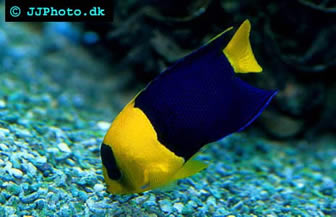Bicolor Angelfish
Centropyge bicolor
Centropyge bicolor is known under several English common names, including Bicolor angelfish, Bicolour angelfish, Two coloured angelfish, Two-colored angelfish, Blue and gold angelfish, and Blue & Gold angelfish.
Centropyge bicolor has not been evaluated for the IUCN Red List of Threatened Species.
Geographical range, habitat and habits
The Bicolor angelfish lives in the Indo-Pacific. Its geographical range stretches from East Africa to the Samoan and Phoenix Islands, north to southern Japan, and south to New Caledonia (throughout Micronesia). It is found from 32°N to 23°S.
The Bicolor angelfish inhabits lagoons, channels and protected seaward reef slopes, including drop offs and environments filled with corals or rubble. It lives alone, in pairs or in small groups and is known to quickly swim from one protective crevice to another. It is rarely found far from a suitable hiding spot. The depth range for this species is 1-25 meters / 3-82 feet.
The oldest known Bicolor angelfish reached an age of 13 years.
Size and appearance
The largest scientifically measured Bicolor angelfish was 15.0 cm / 5.9 in.
This fish is yellow anteriorly and blue posteriorly. The head is yellow and you can see a blue bar above the eyes. The caudal fin is yellow, while the tail is blue. Juveniles look similar to adult fish.
Bicolor angelfish care
The Bicolor angelfish is not an easy fish to keep and many species of dwarf angelfish are hardier than this one. It is only recommended for well established and stable aquariums. Ideally include live rock in the set-up and encourage natural algae growth since this makes it possible for the angel to carry out its natural feeding behaviour. It is not advisable to house a Bicolor angelfish in an aquarium smaller than 55 gallons / 200 litres.
It is very important to provide the fish with plenty of suitable hiding spots in the aquarium, e.g. in the form of crevices. If not, the Bicolor angelfish will become stressed and even more shy than normally and it will most likely spend most of its time hiding. When provided with good hiding spots, it feels safer and becomes more willing to spend time out in the open. This species spends most of its time in the lower part of the aquarium.
The Bicolor angelfish is often seen in pairs and small groups in the wild, but it is hard to keep more than one specimen of this species in the aquarium unless you have a large tank and introduce all of them at the same time. Several hiding spots must be provided for each fish. The same is true if you want to combine the Bicolor angelfish with other species of dwarf angelfish.
The Bicolor angelfish is considered reef safe with caution. It is known to nip large-polyped corals, and it may also pick on clams and small mobile invertebrates.
The recommended water temperature when keeping Bicolor angelfish is 72-80° F (22-27° C), the pH-value should be kept in the 8.1-8.4 interval, and the specific gravity should be 1.020-1.025. A carbonate hardness of 8 - 12° dKH is ideal.
Feeding Bicolor angelfish
In the wild, the Bicolor angelfish feeds on algae, worms and small crustaceans. Ideally include live rock in the aquarium set-up and encourage natural algae growth, since this will make it possible for the fish to carry out its natural feeding behavior. This is a continuous feeder and eating just one or two big meals per day is not the lifestyle to which it is adapted.
Naturally occurring food is rarely enough to keep a Bicolor angelfish well-fed in an aquarium and you should therefore supplement with other foods. You can for instance combine spirulina flakes, fresh, frozen and dried algae, and boiled vegetables with meaty foods such as various suitably sized shrimps and worms. Give the fish many small meals throughout the day instead of just a few big ones. Some specimens must be given fresh algae in live food in the beginning and then gradually be trained to accept flakes, dried algae, etcetera.
Breeding Bicolor angelfish
The Bicolor angelfish is a hermaphroditic harem breeder. It is considered difficult to breed in aquariums since keeping more than one specimen tends to lead to a lot of violence.
Marine Angelfish Articles:
African Flameback Angelfish – Centropyge acanthops
Asfur Angelfish – Pomacanthus asfur
Blueface Angelfish – Pomacanthus xanthometopon
Cherub Angelfish – Centropyge argi
Coral Beauty – Centropyge bispinosa
Emperor Angelfish – Pomacanthus imperator
Flame Angelfish – Centropyge loricula
French Angelfish – Pomacanthus paru
Herald's Angelfish – Centropyge heraldi
Koran Angelfish – Pomacanthus semicirculatus
Lamarck's Angelfish – Genicanthus lamarack
Potter's Angelfish – Centropyge potteri
Queen Angelfish – Holacanthus ciliaris
Regal Angelfish – Pygoplites diacanthus
Rock Beauty Angelfish – Holacanthus tricolor
Rusty Angelfish – Centropyge ferrugata
Watanabe's Angelfish – Genicanthus watanabei

